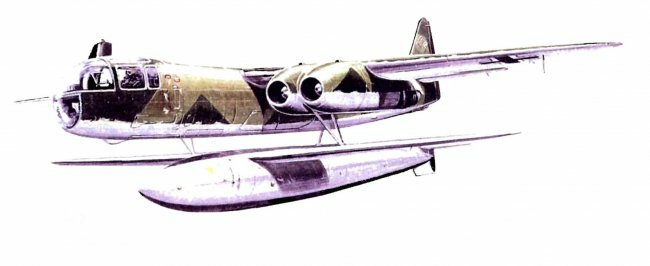Radio-controlled planning bomb Arado E377
One of the latest bombs planning projects submitted to RLM at the end of the 1944 of the year was the Arado E 377 non-propelled, aircraft-type project. In cooperation with Rheinmetall-Borsig, the German company Arado developed a planning bomb designed to be towed on a cable behind an Arado Ag 234 C-2 aircraft or a Heinkel Not 162 fighter and discharged in planning mode to destroy enemy ground and surface targets. Control was carried out remotely or by means of a target tracking device. The documentation provided to department E 2 / 11 RLM fully complied with the requirements of RLM. By its design, the Arado E 377, which was supposed to be made of wood, corresponded to the plane. The fuselage was made in the form of a body of rotation and served as an additional gas tank for the aircraft carrier (in the non-engine version E 377), and also carried an 2-ton warhead. The wing planes of the 377 E were also gas tanks, which, like the fuselage tank, were sealed and filled with inert gas.
Vertical tail had a symmetrical arrangement, a rectangular stabilizer was located above the fuselage. The movement of the rudders of turn and height at the approach to the target was carried out by means of the so-called fighter control from the carrier aircraft after the separation of the planning bomb or by a straight-line flight device. The fuel intake from the gas tank of the disposable E 377 E device in a non-motorized modification was provided by a device driven by a jet engine compressor of an aircraft carrier. Thus it was possible to significantly increase the range.
Both aircraft were attached with braces on the launch car. The advantage of this was that only one lock could open up under load. The launch trolley developed by Rheinmetall-Borzig was an improved version of the three-wheeled launch trolley of the Ag 234 A-2 aircraft, whose weight increased to 4000 kg by increasing the size of the side brackets and adding another pair of wheels.
After the separation of the Mistel coupling (Ag Е377-Аg 234 С-2), the starting carriage was braked with the help of brake rockets and a parachute. Problems with stability on take-off arose only when using a Heinkel He 162 machine as an aircraft carrier. Technicians of the firm "Arado" also provided a pyrobolt for uncoupling the E 377 bomb from the aircraft carrier.
The hitch was assembled before take-off with the help of a loading device and double-deck trestles, which made it possible to install a memory carrier on the Arado E 377.
The modification, intended for use on the Heinkel He 162 carrier, received the designation Arado E 377 "A" (unlike the version for the Arado carrier plane, where the index contained a small "a"). Two BMW 109-003 turbojet engines allowed the E 377 to make an approach to the target at a speed of 750 km / h.
The non-powered Arado E 377 warhead consisted of a Trialena 105 shaped charge (high blasting explosive) with a weight of 2000 kg, especially good for use against surface targets. To defeat large targets, it was envisaged to create a thin-walled bomb, with a rupture close to the characteristics of the mine. In addition, a 500 l of flammable liquid was poured into the rear fuselage, which also improved the balancing of the E 377. Instead of a 2 T warhead, it was possible to mount a conventional SC1800 bomb without a tail.
The creation of a piloted version of the Arado 377, the so-called “kamikaze” projectile following the example of the Japanese (“Bac” bomb), was also envisaged.
The end of the war prevented the production and use of the E 377.



Information